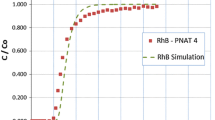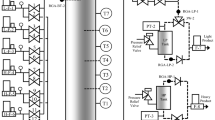Abstract
Modelling of the removal of synthetic dyes from aqueous solutions by adsorbents is important to develop an appropriate treatment plan using adsorption process. This paper presents a computational fluid dynamic model incorporating the Langmuir isotherm scheme and second-order kinetic expression to describe the adsorption process. The governing equation of the model was numerically solved using PHOENICS software to simulate synthetic dyes adsorption from the aqueous system. The experimental results presented in this study and taken from the literature for the removal of synthetic dyes were compared with those results predicted by the numerical model. The predicted outputs of the model match the experimental measurements satisfactory. A sensitivity analysis of the major parameters that influence the percent of dye removal from solution phase has been carried out. Three of the main parameters taken into account were the kinetic rate constant, amount of dye adsorbed at equilibrium and the Langmuir isotherm constant. It was found that the model is most sensitive to the amount of dye adsorbed at equilibrium. This effect is most obvious at the early stages of the adsorption process when the rate of dye removal is very fast. Quantification of the reaction mechanism allows developing an appropriate remediation strategy based on the adsorption process.



Similar content being viewed by others
References
Hachem, C., Bocquillon, F., Zahraa, O., & Bouchy, M. (2001). Decolourization of textile industry wastewater by the photocatalytic degradation process. Dyes and Pigments, 49, 117–125.
Wu, J., Eiteman, M. A., & Law, S. E. (1998). Evaluation of membrane filtration and ozonation processes for treatment of reactive dye wastewater. Journal of Environmental Engineering, 124, 272–277.
Vlyssides, A. G., Loizidou, M., Karlis, P. K., Zorpas, A. A., & Papaioannou, D. (1999). Electrochemical oxidation of a textile dye wastewater using a Pt/Ti electrode. Journal of Hazardous Materials, 70, 41–52.
Pearce, C. L., Lloyd, J. R., & Guthrie, J. T. (2003). The removal of colour from textile wastewater using whole bacterial cells: A review. Dyes and Pigments, 58, 179–196.
Fu, Y., & Viraraghavan, T. (2002). Removal of congo red from an aqueous solution by fungus Aspergillus niger. Advances in Environmental Research, 7, 239–247.
Venkata Mohan, S., Sailaja, P., Srimurali, M., & Karthikeyan, J. (1999). Color removal of monoazoacid dye from aqueous solution by adsorption and chemical coagulation. Environmental Engineering and Policy, 1, 149–154.
Annadurai, G., Juang, R. S., & Lee, D. J. (2002). Factorial design analysis for adsorption of dye on activated carbon beads incorporated with calcium alginate. Advances in Environmental Research, 6, 191–198.
Mohan, D., Singh, K. P., Singh, G., & Kumar, K. (2002). Removal of dyes from wastewater using Flyash, a low-cost adsorbent. Industry and Engineering Chemistry Research, 41(15), 3688–3695.
Atun, G., Hisarli, G., Sheldrich, W. S., & Muhler, M. (2003). Adsorptive removal of methylene blue from colored effluents on fuller’s earth. Journal of Colloid and Interface Science, 261, 32–39.
Aksu, Z. (2005). Application of biosorption for the removal of organic pollutants: A review. Process Biochemistry, 40, 997–1026.
Gong, R., Sun, Y., Chen, J., Liu, H., & Yang, C. (2005). Effect of chemical modification on dye adsorption capacity of peanut hull. Dyes and Pigments, 67, 75–181.
Gucek, A., Sener, S., Bilgen, S., & Mazmanci, M. L. (2005). Adsorption and kinetic studies of cationic and anionic dyes on pyrophyllite from aqueous solutions. Journal of Colloid and Interface Science, 286, 53–60.
Chakraborty, S., De, S., DasGupta, S., & Basu, J. K. (2005). Adsorption study for the removal of a basic dye: Experimental and modelling. Chemosphere, 58, 1079–1086.
Karaca, S., Gurses, A., & Bayrak, R. (2005). Investigation of applicability of the various adsorption models of methylene blue adsorption onto lignite/water interface. Energy Conservation and Management, 46, 33–46.
Tsui, L. S., Roy, W. R., & Cole, M. A. (2003). Removal of dissolved textile dyes from wastewater by a compost sorbent. Coloration Technology, 119, 14–18.
Wang, S., Boyjoo, Y., Choueib, A., & Zhu, Z. H. (2005). Removal of dyes from aqueous solution using fly ash and red mud. Water Research, 39, 129–138.
Garg, V. K., Amita, M., Kumar, R., & Gupta, R. (2004). Basic dye (methylene blue) removal from simulated wastewater by adsorption using Indian Rosewood sawdust: A timber industry waste. Dyes and Pigments, 63, 243–250.
Pavel, J., Buchtova, H., & Ryznarova, M. (2003). Sorption of dyes from aqueous solutions onto fly ash. Water Research, 37, 4938–4944.
Robinson, T., Chandra, B., & Nigam, P. (2002). Removal of dyes from a synthetic textile dye effluent by biosorption on apple pomace and wheat straw. Water Research, 36, 2824–2830.
Namasivayam, C., & Arasi, D. J. S. E. (1997). Removal of congo red from wastewater by adsorption onto waste red mud. Chemosphere, 34(2), 401–417.
Gupta, V. K., Gupta, M., & Sharma, S. (2001). Process development for the removal of lead and chromium from aqueous solutions using red mud—An aluminium industry waste. Water Research, 35(5), 1125–1134.
Çengeloğlu, Y., Kir, E., & Ersöz, M. (2002). Removal of fluoride from aqueous solution by using red mud. Separation and Purification Technology, 28, 81–86.
Yang, Y., Zhang, J., Yang, W., Wu, J., & Chen, R. (2003). Adsorption properties for urokinase on local diatomite surface. Applied Surface Science, 206, 20–28.
Doulati Ardejani, F., Badii, Kh, Yousefi, L. N., Shafaei, S. Z., & Mirhabibi, A. R. (2008). Adsorption of Direct Red 80 dye from aqueous solution onto almond shells: Effect of pH, initial concentration and shell type. Journal of Hazardous Materials, 151(2–3), 730–737.
Doulati Ardejani, F., Badii, Kh, Yousefi Limaee, N., Mahmoodi, N. M., Arami, M., Shafaei, S. Z., & Mirhabibi, A. R. (2007). Numerical modelling and laboratory studies on the removal of Direct Red 23 and Direct Red 80 dyes from textile effluents using orange peel, a low-cost adsorbent. Dyes and Pigment, 73(2), 178–185.
Spalding, D. B. (1981). A general purpose computer program for multi-dimensional one- and two-phase flow. Mathematics and Computers in Simulation, 23(3), 267–276.
Badii, Kh, Doulati Ardejani, F., Aziz Saberi, M., Yousefi Limaee, N., & Shafaei, S. Z. (2010). Adsorption of Acid blue 25 dye on diatomite in aqueous solutions. Indian Journal of Chemical Technology, 17, 7–16.
Gokmen, V., & Serpen, A. (2002). Equilibrium and kinetic studies on the adsorption of dark colored compounds from apple juice using adsorbent resin. Journal of Food Engineering, 53, 221–227.
Shawabkeh, R., Al-Harahsheh, A., & Al-Otoom, A. (2004). Copper and zinc sorption by treated oil shale ash. Separation and Purification Technology, 40, 251–257.
Ho, Y. S., & McKay, G. (1999). The sorption of lead(II) ions on peat. Water Research, 33(2), 578–584.
Rubin, J., & James, R. V. (1973). Dispersion-affected transport of reacting solutes in saturated porous media: Galerkin method applied to equilibrium-controlled exchange in unidirectional steady water flow. Water Resources Research, 9(5), 1332–1356.
Doulati Ardejani, F., Singh, R. N., & Baafi, E. Y. (2004). Numerical modelling of ion-exchanging solute transport in groundwater systems. The PHOENICS Journal: Computational Fluid Dynamics & Its Applications, 16, 18.
Lerman, A. (1979). Geochemical processes: Water and sediment environments (p. 481). New York: John Wiley.
Singh, R. N., & Doulati Ardejani, F. (2004). Finite volume discretisation for solving acid mine drainage problems. Archives of Mining Science, 49(4), 531–556.
Reddi, L. N., & Inyang, H. I. (2000). Geoenvironmental engineering, principles and applications (p. 494). New York: Marcel Dekker, Inc.
Freeze, R. A., & Cherry, J. A. (1979). Groundwater (p. 604). Englewood Cliffs: Prentice-Hall, Inc.
Bahramian, M., Doulati Ardejani, F., Mirkhani, V., & Badii, Kh. (2008). Diatomite-supported manganese Schiff base: An efficient catalyst for oxidation of hydrocarbons. Applied Catalysis A: General, 345, 97–103.
Acknowledgements
The authors would like to acknowledge the financial support made by the Institute for Colorants, Paints and Coatings. The authors also are grateful to Shahrood University of Technology for supporting this research.
Author information
Authors and Affiliations
Corresponding author
Rights and permissions
About this article
Cite this article
Doulati Ardejani, F., Badii, K., Farhadi, F. et al. A Computational Fluid Dynamic Model for Prediction of Organic Dyes Adsorption from Aqueous Solutions. Environ Model Assess 17, 505–513 (2012). https://doi.org/10.1007/s10666-012-9310-x
Received:
Accepted:
Published:
Issue Date:
DOI: https://doi.org/10.1007/s10666-012-9310-x




